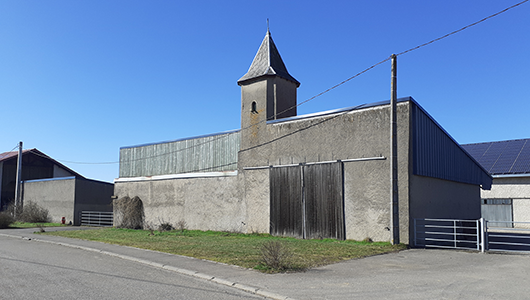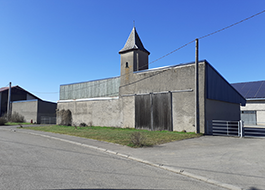Colligny-Maizery
Durée visite : 10 minutes
Moyen : Pédestre
Les archéologues ont découvert les fondations d’un bâtiment agricole du Ier siècle. Le village faisait partie d’une enclave du duché de Lorraine, dans les terres de la principauté épiscopale de Metz. Il appartenait au Pays messin. Un état économique du village existe pour l’année 1860. On compte à cette époque deux marchands de bois, onze coquetiers, six tisserands, deux menuisiers, un maréchal-ferrant, un tonnelier, un charron, deux maçons et deux épiciers. Lors de la guerre de 1870, Colligny fut le siège de deux postes de secours prussiens, durant la bataille de Borny-Colombey. Elle fusionne en 2016 avec la commune de Maizery.
Archaeologists have discovered the foundations of a 1st century agricultural building. The village was part of an enclave of the Duchy of Lorraine, in the lands of the episcopal principality of Metz. It belonged to the Pays Metz. An economic state of the village exists for the year 1860. There are at that time two wood merchants, eleven egg cups, six weavers, two carpenters, a farrier, a cooper, a wheelwright, two masons and two grocers. During the war of 1870, Colligny was the seat of two Prussian aid stations, during the battle of Borny-Colombey. It merged in 2016 with the municipality of Maizery.
Archäologen haben die Fundamente eines landwirtschaftlichen Gebäudes aus dem 1. Jahrhundert entdeckt. Das Dorf war Teil einer Enklave des Herzogtums Lothringen im Land des bischöflichen Fürstentums Metz. Es gehörte dem Pays Metz. Ein wirtschaftlicher Zustand des Dorfes besteht für das Jahr 1860. Zu dieser Zeit gibt es zwei Holzhändler, elf Eierbecher, sechs Weber, zwei Tischler, einen Hufschmied, einen Küfer, einen Radbauer, zwei Maurer und zwei Lebensmittelhändler. Während des Krieges von 1870 war Colligny während der Schlacht von Borny-Colombey Sitz zweier preußischer Hilfsstationen. Es fusionierte 2016 mit der Gemeinde Maizery.

D’azur au croissant d’argent soutenant un lis de même posé entre deux épis d’or.
Armes de la famille Balbo, qui a possédé la seigneurie du XVIe au XVIIIe siècle
Azure to a crescent Argent supporting a lily of the same posed between two golden ears.
Weapons of the Balbo family, who owned the lordship from the 16th to the 18th century.
Azurblau zu einem sichelförmigen Argent, der eine Lilie derselben zwischen zwei goldenen Ohren trägt.
Waffen der Familie Balbo, die vom 16. bis 18. Jahrhundert die Herrschaft besaß.
Les points de visites
.
Il existe une vieille ferme lorraine dite du Colombier. Une grande porte voûtée en pierre de Jaumont marque l’entrée. Un colombier, qui ne touche pas terre, est accessible avec une échelle. A l’intérieur une poutre centrale tourne sur elle-même ; elle permet d’avoir des nids du sol au plafond. L’érection d’un colombier est le privilège du seigneur haut-justicier, comme c’est le cas aussi pour les moulins et pressoirs banaux.
There is an old Lorraine farm known as the Colombier. A large arched door in Jaumont stone marks the entrance. A dovecote, which does not touch the ground, is accessible with a ladder. Inside a central beam spins on itself; it allows you to have nests from floor to ceiling. The erection of a dovecote is the privilege of the high justice lord, as is also the case for ordinary mills and presses.
Es gibt eine alte lothringische Farm, die als Colombier bekannt ist. Eine große Bogentür aus Jaumont-Stein markiert den Eingang. Ein Taubenschlag, der den Boden nicht berührt, ist mit einer Leiter zugänglich. Im Inneren dreht sich ein zentraler Strahl auf sich selbst; Sie können Nester vom Boden bis zur Decke haben. Die Errichtung eines Taubenschlags ist das Privileg des Obersten Richters, wie dies auch bei gewöhnlichen Mühlen und Pressen der Fall ist.
.







